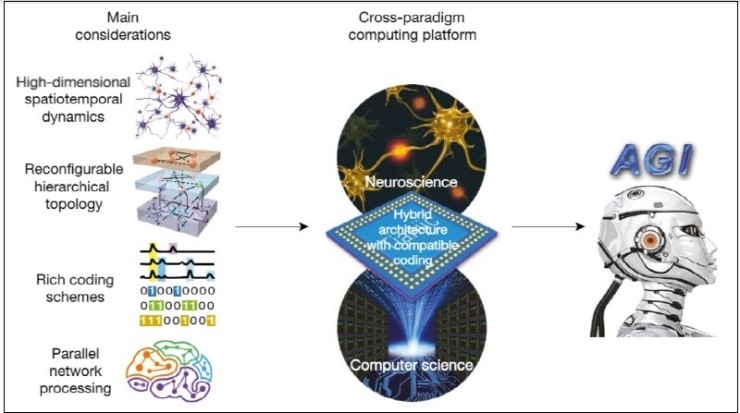중국, AI 칩 탑재 자율주행자전거 개발 VIDEO: This autonomous bicycle shows China’s rising expertise in AI chips
This autonomous bicycle shows China’s rising expertise in AI chips
It might not look like much, but this wobbly self-driving bicycle is a symbol of growing Chinese expertise in advanced chip design.
Look, no hands: The bike not only balances itself but steers itself around obstacles and even responds to simple voice commands. But it’s the brains behind the bike that matter. It uses a new kind of computer chip, called Tianjic, that was developed by Luping Shi and colleagues at Tsinghua University, a top academic institution in Beijing.

中 AGI위한 하이브리드 AI칩 설계, 자율주행자전거 구현 By 강승만 Editor - 2019-08-01 중국이 자체 개발한 인공지능(AI) 칩을 탑재한 자율주행자전거가 공개됐다. AI칩으로 작동하는 자율주행 자전거는 스스로 균형을 잡을 뿐만 아니라 장애물을 회피하고 단순한 음성 명령에도 반응한다. 자율주행 자전거에는 중국 칭화대(Tsinghua University)의 루핑시(Luping Shi) 교수와 연구진들이 개발한 뉴로모픽 칩(neuromorphic chip) 텐직(Tianjic)이 적용됐다. 범용 인공지능(artificial general intelligence, AGI)를 목표로 개발한 텐직칩은 기존의 컴퓨터공학기반 폰 노이만 디자인과 신경과학 기반 두뇌에서 영감을 얻은 두 가지 아키텍처 접근 방식을 하나로 모으는 하이브리드 디자인을 특징으로 한다. 텐직은 AI 알고리즘 실행에 최적화한 새로운 칩 디자인 설계를 제시했다. 이 칩은 중국의 자체 칩 개발과 설계 능력을 암시한다. 중국은 미국과의 무역 전쟁에서 불리하게 작용한 기술력 약점인 자체 반도체 산업 구축에 노력해왔. 이 연구는 중국 연구자들이 전문 AI 칩을 만들 수 있다는 것을 보여주고 있다. 31일 네이처에 발표한 논문에서 칭화대 연구팀은 컴퓨터과학과 신경과학 하이브리드 아키텍처가 AI 미래에 결정적인 역할을 할 수 있으며 AGI 개발을 이끌수 있다고 제안했다.
논문에 따르면 AGI 개발에는 컴퓨터과학 지향(computer-science-oriented)과 신경과학 지향(neuroscience-oriented) 두 가지 일반적인 접근 방식이 있다. 둘 사이 공식과 코딩 체계의 근본적인 차이로 이 두 가지 접근법은 구별되고 호환되지 않는 플랫폼에 의존, AGI 개발을 지연시킨다. 신경과학에서 영감을 얻은 모델 및 알고리즘과 컴퓨터 과학 기반 인공 신경망을 지원할 수 있는 일반적인 플랫폼이 필요한 이유다. [전문] |
edited by kcontents
Two in one: The Tianjic chip features a hybrid design that seeks to bring together two different architectural approaches to computing: a conventional, von Neumann design and a neurologically inspired one. The two architectures are used in cooperation to run artificial neural networks for obstacle detection, motor and balance control, and voice recognition, as well as conventional software.
AI’s future? In a paper outlining the chip and the bicycle, published in the journal Nature today, the researchers suggest that such a hybrid architecture could be crucial for the future of artificial intelligence, perhaps even providing a route toward more general forms of AI. That’s a bit bold, given how far we are from AGI, but Tianjic does show the growing value of new chip designs optimized for running AI algorithms.
Made in China: The chip also hints at the progress China is making in developing its own chip design capabilities. As outlined in this feature article, China has long struggled to build its own chip industry, a major weakness in its technological capabilities that have been exploited in the ongoing trade war with the US. But while manufacturing the most advanced computer chips remains out of reach, Chinese researchers are showing they can make specialized AI chips as well as anyone.
kcontents









